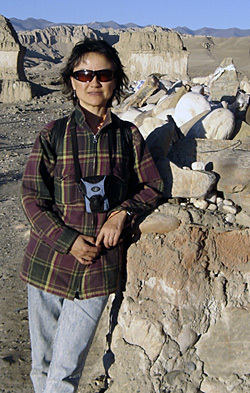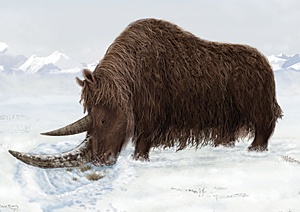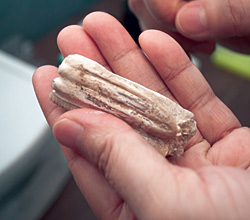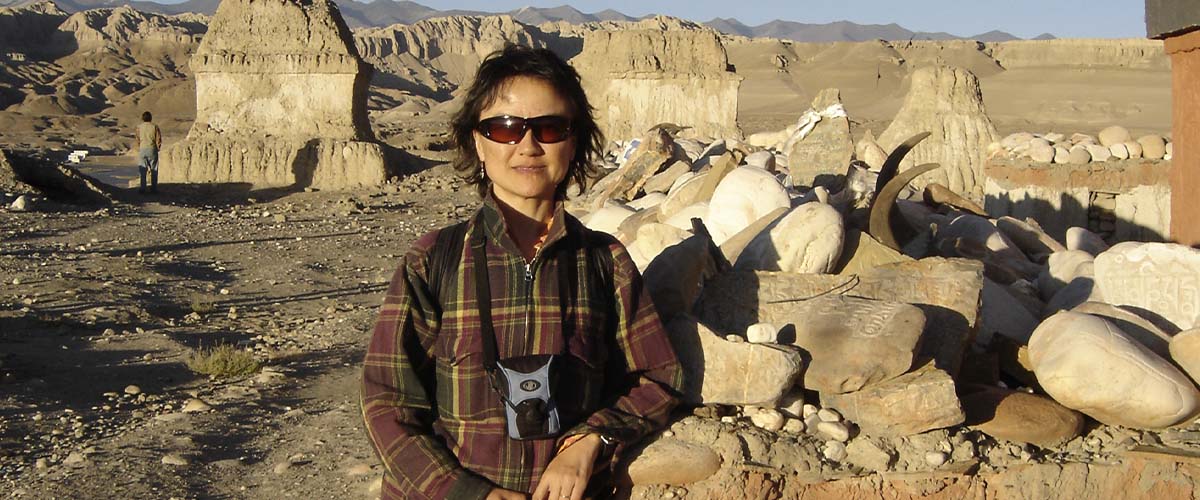Magnet Lab geochemist Yang Wang is known for doing complex research using highly technical equipment. Yet she's also hiked the remote outback of Tibet and camped under the stars in the Himalayas – all in the name of scientific discovery.

Yang Wang in Tibet's Zanda Basin.
Because of her unique mix of skills, she was part of a team that uncovered the bones of the oldest prehistoric woolly rhino ever found. The expedition's research received international attention in the fall of 2011 after it was published in the journal Science.
"This is a significant find," says nationally known vertebrate paleontologist Donald Prothero of Occidental College in Los Angeles, who studies the evolution of woolly rhinos and other mammals.
The team's Tibetan discovery suggests that the woolly rhino, and perhaps other great beasts, wandered and foraged across ancient earth in patterns not previously imagined.
"Yang played a key role in our understanding of the paleoenvironments of the Tibetan Plateau," says expedition leader Xiaoming Wang, the curator of vertebrate paleontology at the Natural History Museum of Los Angeles (and no relation to Yang Wang). "Her field and lab work gave us insights into the paleotemperature and precipitation millions of years ago.
Traveling, Indiana Jones style
Wang's research adventure began in 2007, when she accompanied a group of paleontologists to explore one of the most isolated places on earth: the Zanda (ZAH-dah) Basin in Tibet, at the base of the Himalaya Mountains. The vivid blue sky and undulating mountain views stretch for miles, unhampered by trees or brush. Majestic and wild describe this isolated landscape, yet fail to capture its immense wonder.
But the trip was demanding.
The Zanda Basin (about the size of Connecticut) is nearly three miles high. To travel there, you must first acclimate to such heights or risk altitude sickness: difficulty breathing, confusion and other symptoms that require immediate medical attention.
To avoid that, Yang, a professor in the Department of Earth, Ocean and Atmospheric Science at Florida State University, and the paleontologists from L.A.'s Natural History Museum and the Chinese Academy of Sciences in Beijing spent their first three weeks in a lower-altitude basin, the Qaidam (pronounced TIE-dong) Basin. They camped and searched for fossils at its 1.9-mile-high elevation.
Even though it was summer, Wang often wore her long johns and warmest jackets, especially at night when temperatures can dip below freezing. During the day, the researchers covered their faces with scarves, bandit-style, to guard against the intense sun and wind.
From the Qaidam Basin, they drove to a small town to catch a 15-hour train to Lhasa, the capital of the Tibetan Autonomous Region. But first they stopped to eat.
"When you work at such high altitudes, you get very hungry and I was very, very hungry," Wang, 48, says.
She filled up on the café's greasy food – and was sick and nauseated for three days.
In Lhasa, Wang's stomach still churning, the team rented four-wheel-drive Land Cruisers to take them on the four-day climb up to the Zanda Basin. Along the way, there were six police and military checkpoints, where their permits and visas were scrutinized.
Eventually, even their cars could take them no further. They hiked to the fossil digs – and were rewarded with their big find: a prehistoric creature's intact skull and jaw. Later, the researchers would determine the age of the extinct animal using a dating method called magnetostratigraphy – a time scale for rock layers established by measuring the magnetic properties of the rocks. The data revealed that they had discovered a new species of ancient beast.
"This is the oldest, most primitive woolly rhino ever found," says Wang. "We were all very excited!"
A magnificent beast
They christened their find the Tibetan woolly rhino (Coelodonta thibetana). Woolly rhinos are often mentioned in the same breath with giant sloths, sabertooth cats and woolly mammoths. And indeed, the Tibetan woolly rhino they discovered was an amazing beast.

Scientists say the prehistoric beast used its 3-foot horn to sweep away snow and reveal tasty vegetation.
When alive, it stood perhaps 6-feet tall and 12- to 14-feet long. Its head bore two great horns: One grew from the tip of its nose and was about 3 feet long; a much smaller horn arose from between its eyes. It was stocky like today's rhino, but had long, thick hair.
Prior to the team's discovery, the oldest woolly rhino ever found was 2.6 million years old, making it an inhabitant of the Pleistocene era (2.6 million years ago to 11,700 years ago). The newly discovered Tibetan woolly rhino is 3.7 million years old, making it a member of the Pliocene epoch (5.3 million to 2.6 million years ago).
"The new Tibetan specimens make a convincing case that some of the coldadapted animals of the Ice Age in Eurasia might have originated as cold-adapted animals up in the Tibetan Plateau first, then migrated down when the entire northern part of Eurasia was glaciated," paleontologist Prothero says.
That suggests that the woolly rhino – and perhaps other great beasts – had adapted to cold weather before the Ice Age set in 2.8 million years ago.
Chemical clues
To unlock the Tibetan woolly rhino's lifestyle secrets, Wang examined the chemistry of the rhino's fossilized teeth. To do that she uses a special tool called a mass spectrometer.

MagLab researchers use mass spectrometry to tell what a woolly rhino ate millions of years ago.
"We look at the chemistry of the teeth and bones, to see what the animals ate and what kind of environment they lived in."
Her detailed analysis reveals that the creature ate grasses that grew at high altitudes, which suggests that when the Ice Age arrived, the Tibetan woolly rhino lumbered down from the mountains into lower altitudes.
The expedition team also found horse, elephant and deer fossils. Most of the bones and teeth are being kept at the Chinese Academy of Sciences in Beijing, at its Institute of Vertebrate Paleontology and Paleoanthropology.
Wang and other members of the team plan to return to the basin again in 2012 – and they hope to make more breakthroughs.
"Who knows what we might find when we return?" she says. "With fossils, you never know."
This story was originally published in Issue 8 of flux magazine, a discontinued publication of the National High Magnetic Field Laboratory.
By Kathleen Laufenberg



